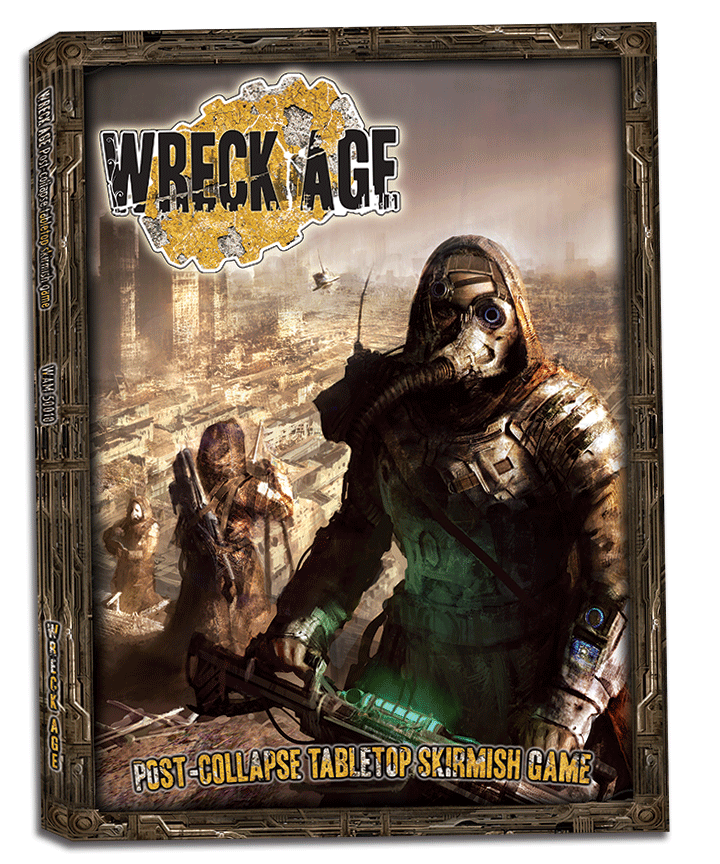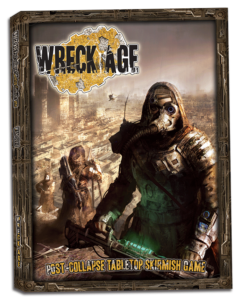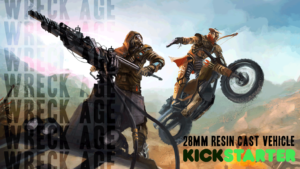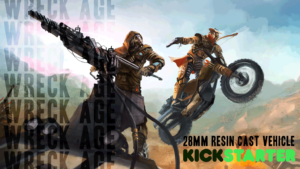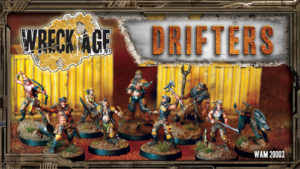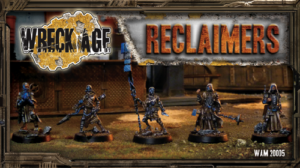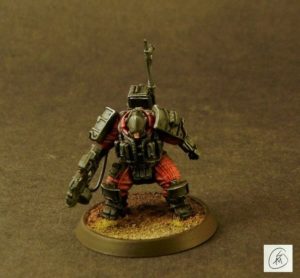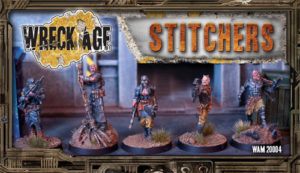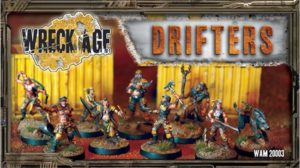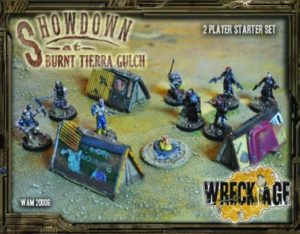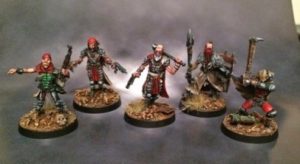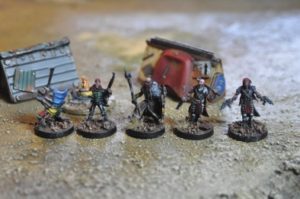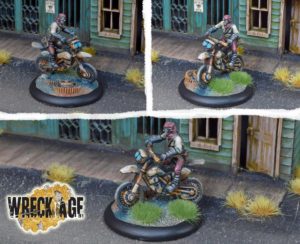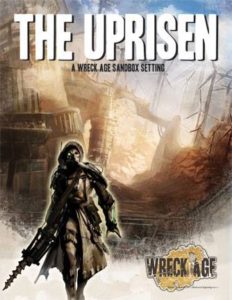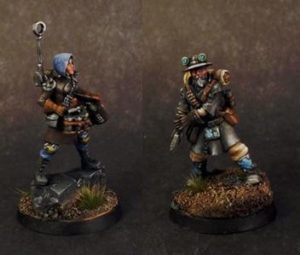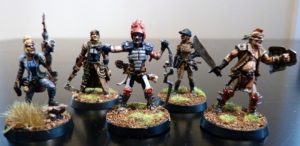Hi everyone, Michael here with a review of a new, narrative-based tabletop skirmish game called Wreck-Age, a post apocalyptic tabletop miniature game/RPG. For more reviews, check out the Tactics Corner.
Wreck-Age is a 28 mm scale miniature game from Hyacinth games, set in a post-collapse/post-apocalyptic version of earth. It has a heavy focus on narrative-style game play and even features guidelines for a campaign Narrator, essentially a DM who oversees the players and plans out campaigns for players to lead their crews through.
I was a big fan of the GorkaMorka skirmish game and it’s Orkish, Mad Max style of gameplay and aesthetics. On top of that, I’m a big fan to post-apocalyptic sci-fi stories and alternative Earth timelines. I’m also a lover of campaigns in 40k, having run a few over the years and delight in coming up with new scenarios and story ideas for them. Due to this, Wreck-Age seemed like a great idea for a skirmish game. You get the figures and battle you enjoy from wargaming, added to a great narrative element to add more depth to your game. I was quite happy when offered the chance to check out the rules and review them for Frontline Gaming.
For this review, I will go through the rulebook and talk about various aspects of the book, what I like and what I didn’t like. I will also give a brief overview of the core rules of the game and the background “fluff” of the game.
Getting Started
The rulebook opens with a really nice introduction story about a couple of characters trying to salvage a vital piece of technology from the time before the collapse; a Fridge. They are set upon by an enemy force trying to gain the technology for themselves. The story is well written and provides an intriguing glimpse of the world in which the game is set.
After that, the book jumps straight into The Basics. This is essentially a glossary of terms you will come across in the rules defining terms such as your Attributes, various different gameplay tests and various more details about the game.
To be honest, this was a bit jarring and could be overwhelming for new players. Having no previous history with the game at all, it was a bit confusing to be reading about Resource Units, Training Levels, Attack Tests, Opposed Tests, etc without any context or introduction to them. It would have been nice to have a paragraph or two about what the game involved and what the point of it was without jumping straight into the rules and defining terms. In fact, it wasn’t until I had read the later sections on Engagements and Campaigns that I started to get a feel for what the purpose of the game was and how it was to be played.
A bit more information up front about the game and what to expect would have served as a nicer introduction in my opinion and given the reader an idea of what to expect.
Building the World
After a couple of pages detailing basic terms and characteristics of the game, the rulebook launches into the history of the Wreck-Age world. This is essentially the background to the game, getting players up to speed with the events that have shaped the world of Wreck-Age.
I really enjoyed this section of the book. Again, it was well written and I found it to be quite an intriguing concept on which to base the game. At this point, I was starting to get into the story and lore of the game, and it started to get more appealing for me. This section features 30 or so pages, detailing the history of the world and some of the locales that are important.
To give you a brief overview of the history of Wreck-Age; the game is set in a world that has recently been ravaged by climate change and corporations. In the near future, corporations became much more powerful entities, usurping their own lands from control of some of the world’s governments and amassing their own armies and city-states. At the same time, climate change has caused major disasters in the world- serious flooding and devastating storms that have contributed to killing millions and reducing land space on Earth.
The Scientific community unites in their prediction that the rampant pollution and climate events will decimate the Earth in the coming decades. The governments and corporations of the world meet in secret to plan the Exodus. They build giant spaceships to carry the best and brightest to colonise other planets. They tell the population that all will be taken, but this is a lie. After the first wave of ships launch, the first Exodus sabotages the systems of Earth, destroying the internet and all computer networks. This plunges the Earth into Chaos.
Attempts are made by those left to form new governments and repair the damage done to the Earth by pollution and climate change. For a while things are stable. However, rampant famine caused by the lack of crops and poor topsoil cause society to collapse once more. The game takes part decades after the second collapse, as the programs enacted to fix the Earth start to bear fruit, as new crops begin to grow. The remnants of Humanity venture out to make their way in the new world.
I really liked the story presented. It is told as a timeline, depicting the events of what has happened “pre-Exodus” and how it led to the events in the game. I like that it is an almost natural progression of some of the troubles faced in this day and age and gives a stark and bleak progression of what could occur in our own world. I also really liked the detail that was put in to the story after the Exodus. They could have left it as “many leave, the Earth descends into chaos, fight it out”, but the details of the attempts to form a new government and fix the issues that was successful for a while, but ultimately failed adds to the story, and gives hope that things could change for the better again. It is a really nice starting point for the game. This is not the bleak, desolate future of the 40k universe. Things are tough for humanity, but there is a chance that they could be better.
Core Rules
The core of the game is based on a D6 system with measurement in inches, which should be immediately familiar for any 40k players. Each player controls a crew consisting of different character models.
There are 8 different factions that can be used in the game:
- STAKERS- These are the closest to common folk in the game. Hardy survivors seeking to forge a new life and civilisation in the world left behind.
- DRIFTERS- Nomadic groups of warriors that tend towards raiding and pillaging.
- STITCHERS- Medics from a crashed spaceship that prey on others, harvesting their organs and knowledge to extend their unnatural lives.
- RECLAIMERS- Fanatical scavengers seeking knowledge and technology from the past above all else.
- ARHK- A conglomerate of corporate entities that stayed behind to try and rule.
- CHURCH OF FUN- A cult of hedonists that spread mayhem in a drug-fueled riot.
- UNICEPHALON- A secret cabal based on the moon that send operatives to monitor and influence the Earth.
- FRINGES- Mercenaries and freelancers living on the outskirts of society.
- CARAVANEERS- Nomadic traders that travel between communities to sell and trade.
Games are meant to be played on a 3 foot square table in most cases, with a few terrain pieces to block line of sight and provide some cover. In Wreck-Age, there is no pre-measuring, so time to dust off those 3rd edition skills and see if you can still estimate ranges well.
The basis of the game is in alternating character activation. Players roll off on an initiative test, the number of dice determine by their character’s Wit value. The highest unique roll wins the initiative and that player can activate a character or force their opponent to activate first.
Characters are able to perform a number of actions based on how many Action Points their character has. This are split into Free Actions (such as yelling to another character or dropping to the ground) that cost no action points, Simple Actions (such as walking, running or firing a weapon) or Complex Actions (such as fixing a weapon or taking an aimed shot). Characters are prevented from taking the same action twice in one turn, so no double running or firing off multiple weapon shots in a single turn.
Some actions can be carried out automatically (such as moving), but other actions will require a test to be passed to be successful (such as shooting attacks). Players roll a number of dice equal to the attribute value for the task and require a certain Target Number to pass. For example, the Beast Handler is trying to perform a task that requires a Wit test. He has a Wit value of 2 and the task is standard, requiring a 4+ to succeed. He rolls two dice (equal to his Wit value) and must score at least one 4+ to succeed in the task. Certain skills, abilities or equipment can modify the Target Number roll in your favour, and there can be bonuses for rolling more than one success on the test.
Players can also perform a Hold Action. This stops them from doing most things in their turn, but gives them a bonus Action Point in their following turn. It also allows you to interrupt the character activation sequence, potentially allowing you to get the drop on an opposing player if the situation is right.
Shooting has various modifiers to influence the difficulty of the shot, including range to target, any cover the target has or their condition (are they fast moving, a small target, or prone, etc). Enemy targets can also be suppressed if they are not wounded by a shot, causing them to reduce the actions they can perform in their following turn. This is a nice way of shooting having some effect on the enemy crew, as they are hindered even if they are not wounded by an attack.
Charging into combat is also achieved by a random dice roll added to a character’s movement, making it possible to fail a charge on an enemy character. Again, there is no pre-measuring, so this can make it a risky prospect. Combat involves a similar dice roll system of requiring to roll a certain score in order to “hit” an enemy character. There are also rules for allowing enemy characters to make overwatch-type shots if they are Holding, or to counter-attack if you fluff a set of attacks against them. Characters can fall back from combat if they find themselves outmatched, but may suffer damage in doing so.
Damage to characters is determined by what is called an Opposed Power Test. Both players roll a number of dice, the number determined by different characteristics for each player. Each success cancels out a success from your opponent. Any leftover success rolls from the attacker results in damage to the defender. For example, the attacker rolls 3 dice and scores two successful damage rolls and the defender rolls two dice and scores one success. One success from the attacker is cancelled by the defender’s success, leaving the attacker with one successful wounding roll. Armour and cover can modify both the number of dice rolled and the Target Number required to cause a successful wound.
If damage is caused, the result can be a character being Wounded, Down, Dying or Dead. A single shot can seriously wound or take a character out of action, so there is no shrugging off multiple gunshot wounds or close combat attacks in Wreck-Age for the most part. A single good shot or combat attack can take a character out of the game, so these attacks can be difficult to get at long range. It doesn’t seem like a game where the goal is to try and wipe out the enemy crew, as this could be difficult under the allotted number of game turns, unless you get really lucky with your rolls.
At the end of a game, characters can be revived through certain special skills and abilities, or can heal over time by missing out games.
Overall, I found the main rules to be pretty good at a first read. I would need to try them out on the tabletop to see how the basic rules mesh with actually playing the game in practice.
One thing I did think the book could benefit from was more examples throughout the text. The shooting section goes into detail about how the range for shots affects the chances of hitting with a shooting attack. These were defined as Point Blank, Short Range, Long Range and Extreme Range. There was no example given of a weapon and the types of ranges involved. I had to skip to the weapons section much further on in order to get a feel for the types of ranges present in the game. Equally, there were discussions of Power levels for damage, but no indication of what types of levels were common or used in the game. Again, I had to skip to the section to find the relevant information. This will probably become more familiar as you play the game (much like any wargame), but on a first pass, it could be a little confusing to read these abstract concepts with no feel for how they applied in the game.
I think the rules should work well within the scope of the game. As I said above, after reading the basic rules, it does not seem like a game will be decided by wiping out the other crew, rather it will be focused on the victory conditions of a particular scenario. This may appeal to players who want more tactical depth from their game, rather than just running up and killing everything. I’m not sure how well the game would function in “pick-up” games, it seems to be more suited for campaigns and linked battles. Fortunately, this is an area where Wreck-Age has a lot of scope.
Character Creation
Wreck-Age seems to be pushing itself as a mix between a tabletop skirmish game and an RPG. This is certainly represented in the character creation section of the book, as well as the section detailing Campaigns that I will focus on later.
Players are pretty much free to create whatever characters they like in the game. You are given some direction if you don’t want to completely go off on your own.
Players must choose a Faction and Archetype (Fighter, Medic, etc) for their character (and crew). They then choose a training level (green to Elite) that determines their base cost. The training level also determines how many Character Development Points they have, which can be split across the different Attributes of a character (Movement, Power, Shooting, Nerve, etc). You then purchase skills and equipment for the character (based on their level) to suit their role in your crew. You are encouraged to flesh out the character with a backstory, interests and motivations.
This gives players a huge range of options to assemble their crew. For players that love making elaborate stories and history for their armies/characters in other games, this will be ideal, giving them free will to carefully craft their own force to their likes and dislikes. For other players, there are plenty of example/stock characters for you to use or copy, modifying slightly to make them your own.
There are a huge range of traits available to flesh out a character, such as Archer, First Aid, Gun Slinger or you can even give your character a Chemical Dependency if you want! Equally, there are a huge number of upgrade options for weapons and ammo, ensuring that no two Characters in your crew need ever be the same.
For those that like detailed customisation of characters in a game, there is a huge amount of detail and options available in the game, and should provide plenty of opportunities for expansion of your crew as your campaign proceeds.
Campaigning
I think that the game has been designed with the thought that players will be competing in a campaign setting, rather than simple one-off games.
One of the big differences that I found with Wreck-Age, making it more like an RPG, is the presence of a Narrator to oversee the campaign.
This is not necessary for a campaign, but one player can act as a Narrator. This is essentially a DM that oversees the whole campaign, determining the missions/scenarios for the other players and advancing the storyline of the campaign and giving the players a reason to interact. They are also encouraged to develop side plots to spice things up in the campaign and give benefits to players that complete them. Certain missions can also include Narrator-controlled characters, allowing the Narrator to still participate in games, as well as running the campaign.
I think this sounds like a great addition to the game. I’m a big fan of running campaigns in 40k, of linking battles together and giving benefits to players for seizing control of certain map areas or building important structures. I think these campaign rules would really appeal to me, or you, if you are that type of player.
Missions can also generate random encounters for players, and again, there are a huge number of examples given in the book, or you can use them as a starting point to create your own. For example, players can come across a chemist’s lab after one of their games. They have the option to buy some drugs, join the Drug Cult or even to kill everyone there and try and loot the equipment and supplies.
These missions can generate new games, where you can play games on your own or against the Narrator. You could even do them with multiple crews; do you work together to take out the Slaver Ring, or will you come into conflict with another crew while trying to raid an abandoned supermarket?
Building your Community
Another interesting aspect of Wreck-Age is creating your own in-game Community for campaigns.
Your community determines how many characters can be created for your crew, their condition and abilities, and what access to different training is available.
Players can spend their Resource Units (essentially the points you have available) to purchase new characters and equipment, to train them up or to advance their community.
This is done by purchasing structures for the community that will add benefits to the campaign or your games.
For example, you need to purchase Shelter for your crew and ensure you have enough food stock to keep them supplied, or they will be unable to fight in your games. Each structure can have associated “building” costs and “Input” costs that are essentially how much it costs you to run the structure and get its benefits. For example, an Infirmary costs 100 resource units to build and costs 30 resource units each campaign turn to keep it running. When it is running, it will dramatically shorten the recovery time for injuring characters, allowing them to return to fight in games much quicker than if they had to heal naturally.
The book also contains advance rules for dealing with radiation or for putting members of your crew into squads, giving them some restrictions in the game, but with some nice benefits for working together.
Overall
Having read the basic rules, I find Wreck-Age to be quite an appealing game. It may not suit every player, but I think some groups will really enjoy the in-depth rules that are provided.
If you are a player that prefers one-off or pick-up games, it may not appeal to you. However, if you have a gaming group that has a love of campaigns and long, overarching storylines for your games, I think you will find a lot of love about Wreck-Age. If you are a gamer that delights in coming up with elaborate stories for your games, or writing intricate campaigns for other players to take part in, this game may also appeal to you. I think that if you have a player in your group that would relish taking on the role of the Narrator in a campaign, you could get a lot of enjoyment out of Wreck-Age.
Wreck-Age has its own models available for the game. After having a quick look at the website, I think they are decent sculpts with some interesting character to them. I think I may have just been spoiled after years of Games Workshop models, but I can see the appeal of the Wreck-Age figures. Of course, there is nothing to stop you using models from other gaming systems for your games. The Necromunda range in particular may be well suited to being used in a post-apocalyptic game.
The rulebook is now available, so if the review has piqued your interest of the game, be sure to check out the rules when they are released and see if you will be diving into the world of Wreck-Age.
And remember, Frontline Gaming sells gaming products at a discount, every day in their webcart!

